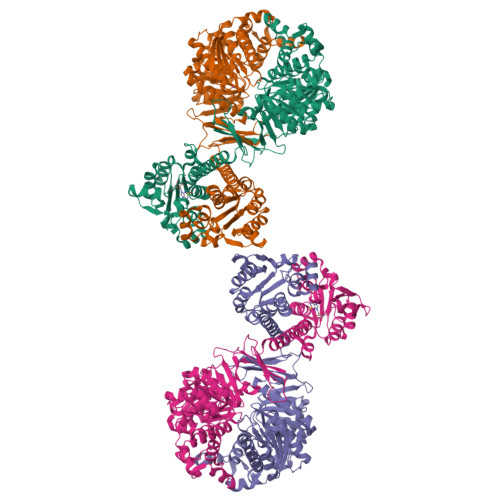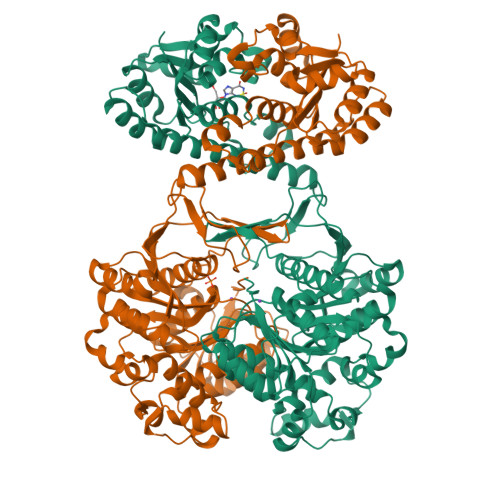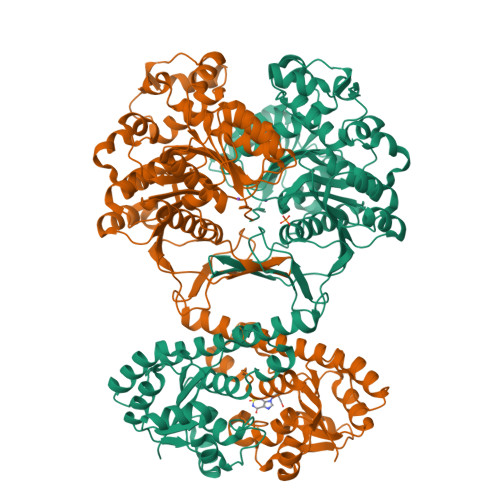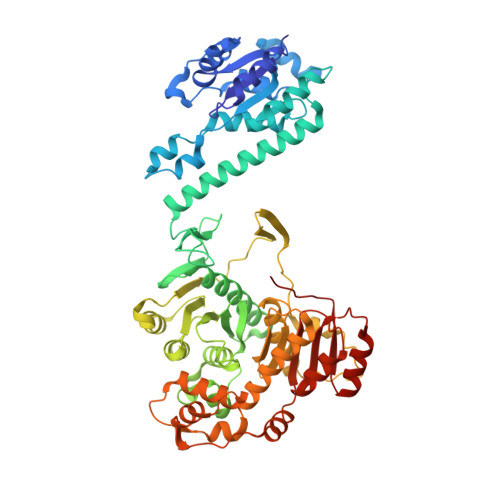Structure-based Design, Synthesis, Evaluation, and Crystal Structures of Transition State Analogue Inhibitors of Inosine Monophosphate Cyclohydrolase.
Xu, L., Chong, Y., Hwang, I., D'Onofrio, A., Amore, K., Beardsley, G.P., Li, C., Olson, A.J., Boger, D.L., Wilson, I.A.(2007) J Biological Chem 282: 13033-13046
- PubMed: 17324932
- DOI: https://doi.org/10.1074/jbc.M607293200
- Primary Citation of Related Structures:
2B1G, 2B1I, 2IU0, 2IU3 - PubMed Abstract:
The inosine monophosphate cyclohydrolase (IMPCH) component (residues 1-199) of the bifunctional enzyme aminoimidazole-4-carboxamide ribonucleotide transformylase (AICAR Tfase, residues 200-593)/IMPCH (ATIC) catalyzes the final step in the de novo purine biosynthesis pathway that produces IMP. As a potential target for antineoplastic intervention, we designed IMPCH inhibitors, 1,5-dihydroimidazo[4,5-c][1,2,6]thiadiazin-4(3H)-one 2,2-dioxide (heterocycle, 1), the corresponding nucleoside (2), and the nucleoside monophosphate (nucleotide) (3), as mimics of the tetrahedral intermediate in the cyclization reaction. All compounds are competitive inhibitors against IMPCH (K(i) values = 0.13-0.23 microm) with the simple heterocycle 1 exhibiting the most potent inhibition (K(i) = 0.13 microm). Crystal structures of bifunctional ATIC in complex with nucleoside 2 and nucleotide 3 revealed IMPCH binding modes similar to that of the IMPCH feedback inhibitor, xanthosine 5'-monophosphate. Surprisingly, the simpler heterocycle 1 had a completely different IMPCH binding mode and was relocated to the phosphate binding pocket that was identified from previous xanthosine 5'-monophosphate structures. The aromatic imidazole ring interacts with a helix dipole, similar to the interaction with the phosphate moiety of 3. The crystal structures not only revealed the mechanism of inhibition of these compounds, but they now serve as a platform for future inhibitor improvements. Importantly, the nucleoside-complexed structure supports the notion that inhibitors lacking a negatively charged phosphate can still inhibit IMPCH activity with comparable potency to phosphate-containing inhibitors. Provocatively, the nucleotide inhibitor 3 also binds to the AICAR Tfase domain of ATIC, which now provides a lead compound for the design of inhibitors that simultaneously target both active sites of this bifunctional enzyme.
Organizational Affiliation:
Department of Molecular Biology, The Scripps Research Institute, La Jolla, California 92037, USA.






















